www.onthewaymodels.com |
Kitbashing a 12.8cm K81/1 gun |
||||
| Article by Al Magnus | |||||
www.onthewaymodels.com |
Kitbashing a 12.8cm K81/1 gun |
||||
| Article by Al Magnus | |||||
|
A Brief History
Barrel changes 
Fortunately with the example used for this build, Ace's barrel collar didn't have the large voids as found in my previous K81/2 build, and once again the barrel was replaced with a turned aluminum piece from Aber (item no. 72 L-19), designed for the Jagdtiger, but useful for this towed gun as well. This is a superb piece and even contains rifling inside the muzzle. The remaining plastic, the breech, barrel collar and recoil mechanism, still needed much sanding and scraping to be presentable. The slot for the elevation arc (part 59) was filled. Detailing as performed on the K81/2 was again done here using small punched disks to represent various missing bolt heads. The Modell Trans gunner's recoil shield was added at this point, after just a smidge of sanding needed to remove some resin to make it fit. Cradle changes The Modell Trans conversion set (kit no. MT72399) provides an arc support and barrel molded to each other. As reviewed previously, there is also an amorphous blob of resin between them that shouldn't be there. Thus the support was removed, destroying the barrel in the process, but it was pretty much useless anyway. After much trimming, scraping, and sanding, the offending resin blob was gone and the Modell Trans support was tested against the Ace barrel. This revealed a diameter difference between the two pieces, so the trunnion mounts were trimmed almost flush to the Ace barrel. That didn't solve the issue completely, so further trimming and sanding of the two parts eventually succeeded in getting them to fit together, though the fit was tight and care was needed to prevent damaging the Modell Trans part. Just before painting commenced I discovered that the set of holes on Modell Trans' arc support should actually be bolt heads. This was remedied with some punched disks glued over the holes. The final task involved adding the elevation arc gear to the new Modell Trans support. The arc was removed from Ace part no. 59 and glued to the support's bottom. 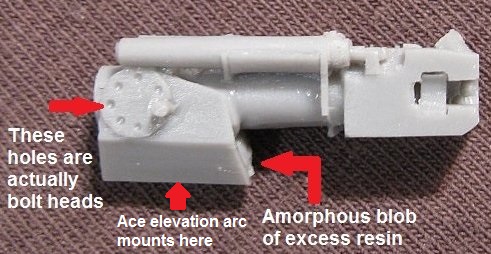
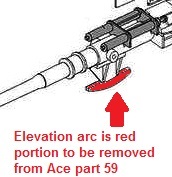 Mount and carriage construction RPM's GPFT kit (kit no. 72602) supplied the carriage and mount. This was, as per the previous build, constructed without much ado. Parts were well molded, detailed and fit together with little trouble. Only filling a few low spots on the trail legs slowed construction. The kit's spades required modification to match, as best as I could, the photo below from reference [1]. 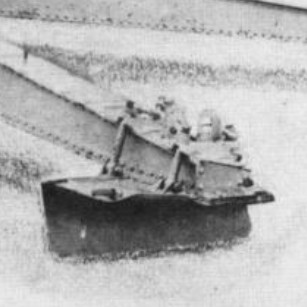 To do this, the upper plates (part 86) were sanded to remove a molded on ridge that runs around the underside of the perimeter. The lower part of the spade (part 96) is unused. 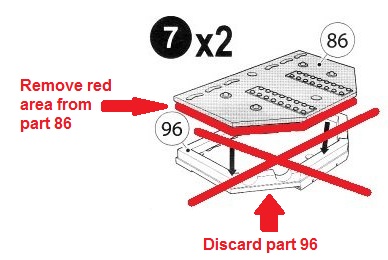 Next, the top plates were shortened width wise to just outside of where the tie down rings (part 41) mount, then they were glued to the trail. There is an alignment hole in the top plate that requires filling. A pair of rectangular pieces, slightly wider than the top plates, were fashioned from some plastic rod. Their dimensions were based on a guesstimation. Then their lower corners were notched, and one plastic piece was attached to the front of each top plate. 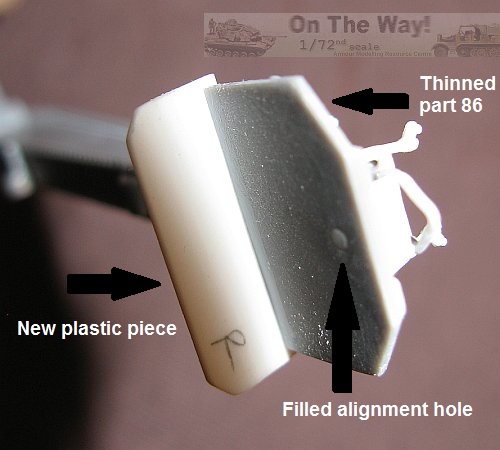
Above is the end result. With that done, all the sub-assemblies were loosely assembled together to make one final check that everything looked acceptable before painting commenced (see below). 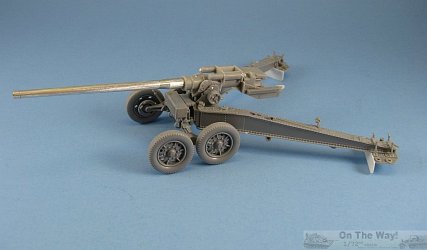
References [1] Waffen Revue Nr. 50: III Quartal 1983, Journal-Verlag Schwende, p. 7963-7994 [2] Antitank Artillery of the Wehrmacht 1939-45, Maxim Kolomiets, MK Strategy, Moscow, Russia 2006 ISBN: 5-901266-01-3 [3] Wydawnictwo Militaria 258: Panzerabwehr Artillerie, Maxim Kolomiets, Wydawnictwo Militaria, 2006 ISBN: 83-7219-258-8 [4] Wydawnictwo Militaria 392: Panzerabwehr Artillerie, Maxim Kolomiets, Wydawnictwo Militaria, 2013 ISBN: 9788372193926 (a slightly modified reprint of [3]) [5] axisafvs.blogspot.com [6] wikipedia [7] Encyclopedia of German Tanks of World War Two: A Complete Illustrated Directory of German Battle Tanks, Armoured Cars, Self-Propelled Guns and Semi-tracked Vehicles, 1933-1945, Peter Chamberlain & Hilary L. Doyle, Arms & Armour Press, London 1993 ISBN: 1-85409-214-6 End result 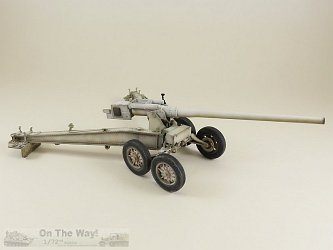
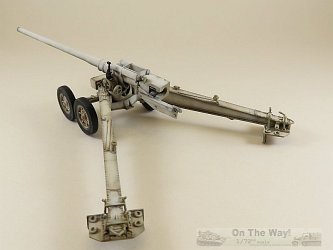
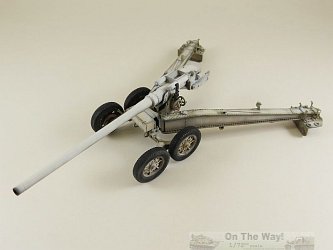
|
| Back to Articles Page | Back to Home Page |
Article Last Updated: 03 January 2022 |
|